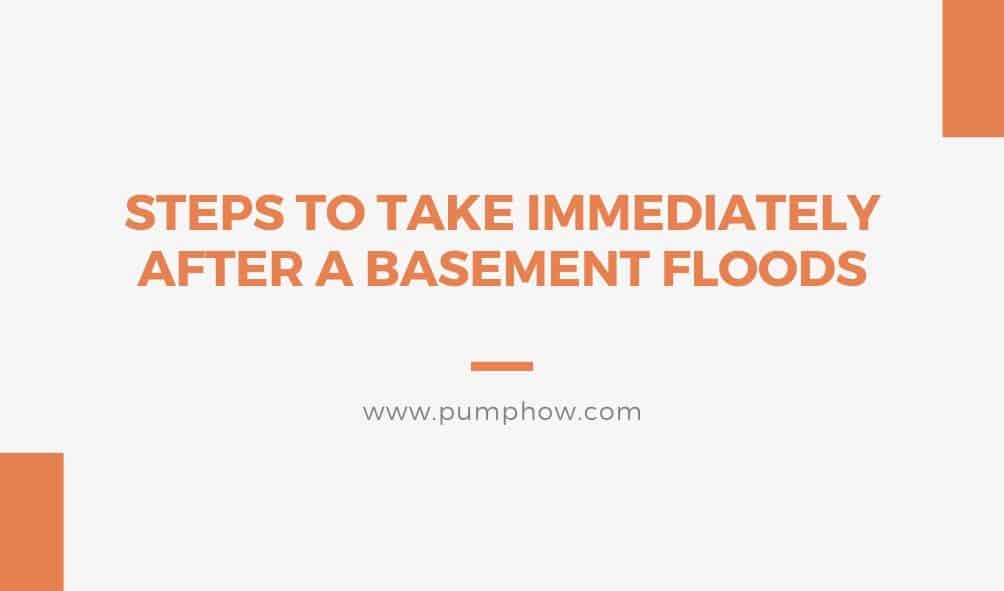The effects of flooding can be so extensive that even the most practical of humans can lose the sense of duty and feel panicked to see that the basement is flooding.
Floating boxes/bowls, soaking papers, sopping upholsteries, and oil slicks are all that might make you feel perplexed and wonder what to do first.
But, you know it’s neither the right thing nor the time for stalling. The way you move forward will determine if you can get past this unwanted situation soon enough. Don’t worry!
Here’s a detailed guide to show you what to do when your basement floods and how your household gets back to its regular way.
10 Tips to Follow When You Have a Flooded Basement
The first seven tips are explained to help you handle the situation, and the next three suggestions are meant to enhance your home’s defense against flooding and your preparedness in the event of such a calamity.

1. Avoid Common Mistakes After Basement Flood
A flooded basement offers an unwelcome sight to unsuspecting eyes. Frustration, hesitation, and hastiness are common, and these feelings invite a lot of mistakes that cause the homeowner who makes them to experience inexplicable sufferings.
- Before you even think of doing anything, shut off your home’s electrical power. Do the same to the gas connection and water lines. If you can’t do it to the entire system, make sure the connections/lines to the flooded and its surrounding areas are shut off.
- Don’t bring your pressure washing appliance inside the home. Keep it for outdoor uses only.
- Don’t walk on the wet surfaces without care. Tread carefully as you might slip and fall.
- Don’t allow your kids anywhere near the water. Discourage all others who won’t be engaged in the cleaning job.
- Try not to use a generator or anything that uses diesel or petrol. If you can’t help, take them out of the indoor basement.
Resort to Insurance Coverage If You have
Don’t be too late to call your insurance company if your situation falls under the coverage plan. Some homeowners call their insurance providers but only being too late to report the actual loss.
You don’t have to wait too long for this. Just make a call and let the company do the rest. It’s good to have been able to confirm the claim procedure, coverage limit, and deductible amount.
2. Use Safety Clothes
A flood in your basement is the welcoming host of various health risks, particularly wastes, waterborne germs, bacteria, viruses, toxic chemicals (carbon monoxide, petrol, acid, etc.), and other harmful substances. In order to prevent yourself from being exposed to those things, you need to have the right protection for your body.
What could be better than a pair of gloves and boots with an overall? Well, that should be adequate for most homeowners, but all those items need to be waterproof. Rubber boots and gloves are very useful in this regard. Sometimes, only gloves and boots work just fine, especially on occasions when the flood isn’t much of a disaster.
Since there are chances that you’ll be doing a lot of hosing, scrubbing, and pressure-washing, and there will be sewage water, your body is likely to have the risk of overexposure to some harmful gases. For protection against these issues, you can rely on standard face masks and goggles which are available at the local DIY stores.
While using these safety items at your disposal, you must be aware of a few things. Wash both your hands with recommended liquids as you’re done with the cleanup. Don’t throw away those items after a single use because they’re reusable and require proper cleaning. So, wash them thoroughly if you’ve used them at least once.
3. Identify the Cause and Stop Flooding (if it still continues)
Knowing why the basement has been flooded is very important because this knowledge helps you figure out how to stop it and what to do next. After all, you can’t let the flooding continue to get your home submerged eventually.
Maybe, the reason why all the flooding has occurred is too critical for you to handle, you can at least call the right professional(s) to do that for you if the source is known. Start looking every nook and cranny of the basement and try to find out the spot the water is coming through. While you might find more than one source, the most common places to look for have been described here.
The water may come through the floor/foundation of your building, walls, or windows. Perhaps the water table is too high or there’s heavy rainfall in your area. Situations such as these often end in sheer frustration because you may have to wait and see if the weather becomes normal again.
If the water is favorably deep (at least within a limit of safety), you need to shut off the power to your basement and move whatever you can to places within your house where there are higher spots.
If the floor drain is the source of basement flooding, you should check the sump pump if there’s one installed in your home. A faulty drainage system may also be the cause. Address the issues that emerge from those sources.
Sometimes, the sewer system run by the municipal authority can be responsible for such issues. In case the drainage system or sump pump is okay, and your plumbing contractor confirms it’s the city’s sewer lines that are at fault, you need to contact the associated department immediately before doing anything else on your own.
Seeing that the hoses/pipes to the water heater or washer is spewing the extra water, you can’t blame nothing but those pipes. Shut off the water to that piece of broken fixture.
At times, you can be sure that the plumbing system has become faulty, but you may not have the luck to identify the specific fixture that has gone wrong. Stop guessing or wasting time to figure out and shut off the water to your house.
After knowing what to take care of and doing just what it takes, you’ll ready to take some real measures to deal with the incident.
4. Get Rid of the Water and Solids
Removing the standing water gives homeowners an annoying experience. But, you’ll have to do it anyway. If the standing water isn’t very deep, you can start with buckets and then mops. For water that is a few inches deep, you can use a wet/dry vacuum machine (links to amazon open in a new tab).
Some homes have these appliances while others don’t. You can rent one from the local hardware shop. If flooding is severe or frequent in your area, you should get yourself one instead of renting.
Although it may seem unlikely to have solids in the water, you may still see them. Since your home is the host of most of these solids, you can simply pick them up and put them in the disposal. For solids that seem to have come from beyond your home, you need to be careful.
5. Take Care of Your Belongings
It’s time to think about the belongings that went under the water or were affected by it. Don’t think they had water damages only. Salvage as many/much of them as you can. You can’t move all of them at a time, and some items are more valuable than others. Set your priority keeping these factors in mind.
- On most occasions, homeowners want to preserve documents, such as property and automobile titles, business/partnership deeds, driving licenses, passports, academic/official papers, financial records, etc.
- Some people emphasize rescuing family keepsakes, such as books, ornaments, heirlooms, souvenirs, photo albums, gift items, and other articles.
- Saving electronics and other home appliances like laptops, computers, TVs, and other portable or smart gadgets is a common thing to imagine.
Once you’ve determined which valuables and/or electronics you want to save; you have to take them to somewhere safe and dry. It can be the upstairs, or somewhere far above the ground.
Chances are that the documents have got dampened if not completely destroyed. If it’s possible for you to use the freezer, preserve the papers in there. You can also use other appliances to dry them. Keeping them dry helps them stay away from further deterioration.
Some homeowners have a collection of storage bins, concrete or wooden blocks, cardboard boxes, and other storage options. If you’re one of them, use whatever is available. Plastic containers or bins are often desirable.
However, not all things should be collected and put away for preservation. If one of your possessions gets ruined to its core, you should remove that. Be careful about the following items.
- Electronics and gadgets that got partially or fully damaged
- Wet, unwashed fabric items kept untreated for a couple of days
- Just about anything that looks pretty messed up
For items like carpet, rugs, upholstered furniture, or similar belongings, you should contact cleaning or restoration professionals instead of throwing them away in an instant.
6. Clean and Sanitize
First, you need to rip up all the carpeting on the floor and get them away from your basement because that part is the potential host of mold/mildew. Then, you should move onto the cleaning phase.
- Start by scrubbing the floor. Mix chlorine bleach or any recommended cleaning solution with warm water to prepare a good solution. Scrub the hard surfaces that can be made of vinyl tile or linoleum properly and then apply the solution. Do the same to clean your walls.
- If you’ve any fabric or furniture item that hasn’t been damaged yet, clean them with soapy, warm water. Keep the uncovered parts of your body safe during this process.
- Use special mold control solutions or products to wipe down the areas that got exposed to the dirty water.
7. Dry the Affected Area and Items
After a flood, mold growth is pretty common. Associated with the growth is the potential damage to your property in the long run. So, removing the water is not all you should do. It’s just a part of the process. You must dry the surface thoroughly. The faster this is done, the more successfully the growth can be prevented.
It’s all about dealing with the dampness of the basement since there’s no standing water at this stage. There are certain ways to facilitate the drying procedure.
- Open your basement windows unless the weather forbids so that the moisture can escape.
- Bring a few fans and set all of them up throughout the basement. Position the fans in a way that they can blow the moisture out of your basement either toward the stairs or through the windows. Set their speed to the highest to make the evaporation speedy.
- You can use space heaters to make the evaporation even faster. Set all of them up throughout your basement. Doing this, you’re being responsible for a humid environment for the basement. So, use a dehumidifier with the heaters; so, the basement doesn’t catch a humid state.
- Leave the cleaned items to dry or use the heaters if necessary.
Make sure that you’ve proper ventilation in place so that you can avoid any harmful fumes during the cleaning and drying process.
Some flooring spaces have bricks under them. You have to ensure an unblocked state to allow for cross ventilation. With the walls and floorboards drying out, you may see loose dust and material in the process. Those unwanted things need to be vacuumed regularly.
Moreover, when you’ve so many things to dispose and you think a little bit help is necessary, you can look for a dumpster rental.
8. Handle the Aftermath Carefully (Start Living)
After you’ve completed each step successfully, you should be ready to live in your home just as you used to before the flood. But, you shouldn’t do it right away because it’s time to face the aftermath of what has happened.
You shouldn’t use the flooring or other things right after cleaning or drying them. Avoid getting in a direct contact with any of them for several days. The basement may require at least two days’ time for drying.
Since the floor can’t be avoidable, use caution (footwear or safety gear) while walking on them. Advise your kids if any to follow your actions regarding this.
Pests, rats, and other rodents might be a problem. So, deal with them cautiously. Don’t approach or corner them without preparations to contain them in a safe way.
9. Call Professionals for Detailed Inspections
This particular step isn’t compulsory if you’re confident that you haven’t made any mistake while cleaning or disposing. But, it’s just peace of mind to know that your home is healthy enough to let you live safely.
- Call your favorite plumbing contractor to check and see if there’s anything wrong with the home’s plumbing and drainage, sump system, etc.
- Invite your acquainted building contractor to get a full report on the structural condition and other relevant factors.
- The gas and electrical system should also be inspected for any potential hazard.
- You can also have a test of your home’s water filtration system to stay assured that the flooding didn’t affect it.
10. Focus on Preventive Measures
After learning everything from the above sections, you might not be interested in doing them again and again instead of taking some steps to prevent flooding. Dealing with a flooded basement and taking preventive actions may not be the same, but they’re relative because the latter saves you the most of the hassles of cleaning and other essentials.
In practice, it’s a huge responsibility, but we won’t annoy you by giving all the details. Here’s only a list of actions you can take to prevent future flooding.
- Inspect your home’s exterior portions to see if there are cracks in the foundation. Use epoxy to handle the cracks. You can also use masonry sealers. Finally, you must contact a professional if the issue seems more complicated.
- The sewers may become clogged and septic system over-taxed. Pay attention to these sections.
- If yours is a below-grade basement, don’t forget to use window well covers which, if fastened and latched securely, help waterproof the basement.
- Install a sump pump if your home doesn’t have one. For an existing pump, you should spend some time to apply maintenance.
Examine and Clear the Drainage System
Inspect the drains and steps of your basement. Get rid of all leaves, mud, and twigs lying in there. Remove the cover or screen of the drain and clean it properly. Reaching inside the drain can be hard. You can use a plumber’s snake or plunger for greater convenience. Examine the gutters and downspouts and clean them as well.
Final Words
And that brings us to the end of this comprehensive guide. We hope you’ve understood your responsibilities to deal with a flooded basement and all it’s adversities. Still, got a question? Write to us for an answer.






